What is Faux Leather? It’s Quality & Durability Against Other Leather!
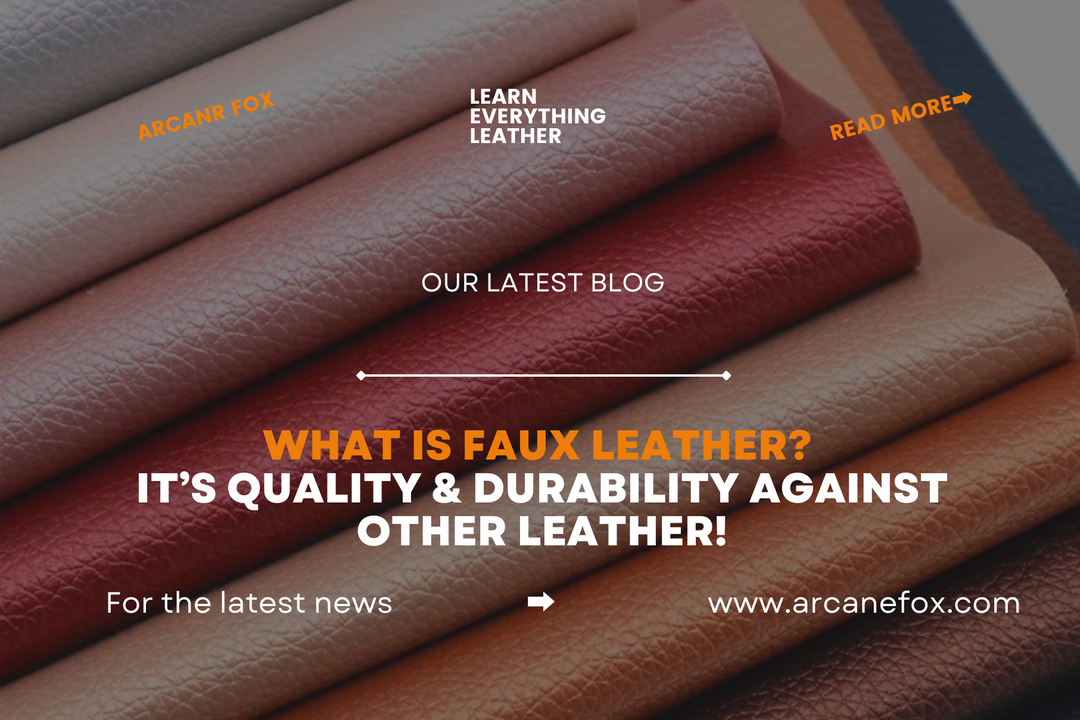
What is Faux Leather? It’s Quality & Durability Against Other Leather!
The term faux has been around for a while and is currently the hot new word in fashion. From fashion garments to accessories, décor, and furnishings, imitation leather has never been more popular than it is now.
With so much talk about faux, often known as synthetic and artificial, many people are still perplexed by it or its distinguishing characteristics, which have become tough to discern. Because of significant advancements in manufacturing procedures and finished products.
1. What is Faux Leather?

Faux leather, often called synthetic leather, is a petroleum-based alternative to genuine leather. It offers many of the same appealing qualities as real leather without requiring harm to animals.
Like authentic leather, faux leather is soft to the touch and water-resistant. This makes it highly resistant to stains and easy to clean. While it’s not as durable as genuine leather, synthetic leather resists abrasions and cuts, making it a suitable choice for upholstery in households with children or pets.
Most synthetic leather manufacturers produce this material in the same colors as genuine leather, but it can be made in virtually any color imaginable. Some brands experiment with vibrant shades like yellow, green, purple, or even blue to stand out from the genuine leather market.
Faux leather is also effective at insulating body heat, making it a popular choice for outerwear like leather jackets and leather coats. At first glance, distinguishing real leather from fake leather can be challenging. However, even those with limited fabric knowledge can often tell the difference by touch—synthetic leather feels more like plastic, which is the most notable distinction between the two materials.
Animal rights advocates praise faux leather for eliminating the need to harm animals, but environmentalists criticize it for being non-biodegradable and for the harmful chemicals released during its production. To address these concerns, some manufacturers have begun creating vegetable-based synthetic leather, offering a solution to both the ethical issues of real leather and the environmental impact of traditional faux leather production.
2. A Brief History of Faux Leather

One of the earliest types of faux leather was called Presstoff, a fabric that remains in production to this day. Invented in Germany, Presstoff gained prominence during wartime when genuine leather was heavily rationed.
It was made of paper pulp and used for a variety of purposes except for shoes, as it could not withstand damp conditions. However, this material never became widely popular outside Germany, as consumers quickly gravitated toward other leather alternatives with more appealing qualities.
Synthetic leather gained international attention with the invention of Naugahyde in 1920. This innovative material was developed by the U.S. Rubber Company, founded in 1892. After years of research, the company’s engineers created a practical leather substitute initially used in handbags.
For decades, the brand name “Naugahyde” was virtually synonymous with synthetic leather. This material became widely used in various industrial applications throughout the 1930s. During the 1940s, the U.S. Armed Forces also relied on Naugahyde for several wartime purposes.
Faux leather also gained traction in the early 1900s when researchers in the United Kingdom began embossing cloth with a mixture of chemicals and pigments. This material was widely used for upholstery and car interiors. In 1963, the first polyurethane substance was introduced, paving the way for the invention of leatherette or PVC leather, which became another popular alternative to genuine leather.
While some historians argue that the origins of faux leather date back to the 15th century, early Chinese attempts at synthetic leather production never achieved significant scale. It wasn’t until the development of petroleum-based plastics in the late 19th century that mass production of a viable leather alternative became possible.
Following the U.S. Rubber Company’s lead, numerous other manufacturers began producing synthetic leather products from the 1950s onward. While Naugahyde dominated the artificial leather market for much of the 20th century, competing brands gradually eroded its market share in the later decades.
The 1970s environmental movement brought greater awareness of the ecological issues surrounding synthetic fabrics. As a result, public perception of faux leather production began to shift negatively. Over the last few decades, manufacturers have worked to develop alternatives to petroleum-based faux leather, which is non-biodegradable and harmful to the environment.
Although many of these efforts have fallen short, some companies have succeeded in creating non-PVC versions of synthetic leather in recent years. However, vegetable-based artificial leather has yet to significantly impact the global faux leather market.
3. Clearing up Myths & Misconceptions
One common misconception about faux leather is that it is completely waterproof. This is just partly correct. Because it is constructed of plastic, it is more waterproof than genuine leather, but continuous exposure to moisture causes damage.
Another common misconception regarding faux leather is that they are all the same in composition, appearance, and feel. This is also false because several types of imitation leather, all with different makeups, have a distinct look and feel that differs slightly from real leather.
4. How is Faux Leather Made?

Manufacturers use various production processes to made faux leather. For example, Presstoff is made by treating paper pulp with a special resin that enhances its durability. However, its inability to withstand wet conditions or significant flexion has limited its widespread use.
Most faux leather available today consists of a base textile coated with plastic. The two primary plastics used in synthetic leather production are polyurethane (PU) and polyvinyl chloride (PVC). While the methods for producing these plastics differ, the processes for binding them to base fabrics are largely similar.
4.1 Obtaining the Base Material
Faux leather manufacturers typically use cotton or polyester as the base material. These fabrics are usually porous and rough, requiring special manufacturing techniques. While some faux leather manufacturers produce their own base materials, it is more common for them to source these materials from third-party suppliers.
4.2 Formulating the Plastic
The next step involves creating the plastic substances that will be bonded to the base fabrics. PVC, for example, is made by combining salt and petroleum components. Salt is subjected to electrolysis to produce chlorine, which is then combined with ethylene, a petroleum derivative.
This combination forms ethylene dichloride, which is converted into vinyl chloride monomer through high-temperature processes. These monomers are polymerized into polyvinyl chloride resin. To make PVC flexible for faux leather production, manufacturers add plasticizers, enabling it to adhere effectively to the base fabric.
The production process for PU is more complex, involving isocyanates, polyols, and various additives. The polymers used in PU production undergo reactions and processing to form the final material. Similar to PVC, plasticizing agents are added to PU to achieve the flexibility required for synthetic leather.
4.3 Binding the Materials
Once the plastics are prepared, manufacturers bind PU or PVC to the base textiles. This step usually involves melting the plastic and layering it onto the underlying fabric.
4.4 Cutting and Preparing the Fabric
After binding, the faux leather is cut into the desired sizes and shapes. Typically, it is sold in long strips by the yard.
The production process for vegetable-based faux leather differs from these steps. Each company making this type of leather uses its own proprietary methods, which remain unique to their production practices.
5. Where Is Faux Leather Fabric Produced?

China is the largest producer of faux leather globally. It also has the most extensive market for synthetic leather products, exporting them to consumers in Asia, Europe, South America, and North America.
As more countries achieve first-world industrialization levels, the global demand for faux leather products is expected to rise. The relatively low cost of synthetic leather compared to genuine leather continues to make it popular in regions where poverty is prevalent but demand for weather-resistant textiles is high due to challenging climatic conditions.
5.1 How Much Does Faux Leather Fabric Cost?
Since faux leather is produced in a fabric form and doesn’t require weaving, its cost is measured per yard rather than per pound. Prices vary depending on the type of synthetic leather but typically range from $10 to $25 per yard.
Established types like PU and PVC leather are generally more affordable, while newer forms, such as vegetable oil-based leather, tend to be significantly more expensive. Bulk discounts may be available for large orders of synthetic leather.
5.2 Faux Leather Fabric Certifications Available
Currently, there are no certifications specifically for faux leather fabric itself. Due to its inability to be recycled and the extensive chemical processing involved, even plant-based synthetic leather cannot qualify for organic certification.
However, the production processes for faux leather can be certified as environmentally friendly. For instance:
- The Greenguard Environmental Institute certifies manufacturers who meet environmentally-friendly standards for synthetic fabric and fiber production.
- Leadership in Energy and Environmental Design (LEED) offers certification for sustainable production practices across various industries.
Individual manufacturers may also provide certifications to confirm that their products meet specific standards or are genuine.
6. Uses of Faux Leather Fabric
Faux leather serves as a direct substitute for genuine leather and is utilized across various applications, including:
Upholstery:
- Sofas
- Chairs
- Car seats
- Coffee tables
- Wall hangings

Apparel and Accessories:
- Handbags
- Shoes and boots
- Gloves
- Hats

Outerwear:
- Jackets (though it doesn’t withstand the elements as well as genuine leather)

Other Items:
- Suitcases
- Briefcases
- Watch bands
- Smartphone cases
- Camera cases

6. Different Types of Faux Leather
Each variety of faux leather possesses unique characteristics, making it suited for specific applications:
6.1 Poly Vinyl Chloride (PVC) Leather
PVC leather, or polyvinyl chloride leather, is a long-lasting material that requires little maintenance. This material, often known as vinyl, contains numerous layers that contribute to its longevity. It is the most waterproof and non-porous of all faux leather fabrics.
6.2 Polyurethane Leather
Polyurethane (PU) leather is created by coating the fibrous component of genuine leather hide in polyurethane, a type of plastic. It is less expensive than real leather, but it is more prone to moisture damage and loses suppleness with time, just like other varieties of faux leather. Faux leather is frequently used for:
- Shoes
- Clothing
- Bags
- Upholstery

6.3 Silicone
Silicone leather, often known as leather, is a cloth that has been silicone-coated to mimic real leather. It contains fewer chemicals and is similar to PVC and PU leather, but it is considerably tougher and more moisture-resistant. Silicone leather is more environmentally friendly and odorless than other imitation leathers and holds its shape better over time.
6.4 Vegan Leather
A durable substance made of polyurethane, cork, apple peels, or recycled plastic, or vegan leather. Vegan leather is excellent for high-wear items since it is incredibly robust, resists fading and scratches.
- Shoes
- Boots
- Bags
- Gloves

7. Advantages and Disadvantages of Faux Leather
7.1 Advantages of Faux Leather
While faux leather has its downsides, it also offers numerous advantages, making it a popular choice in many industries. Here are some key benefits:
- Animal-Friendly: No animals are harmed during the production of synthetic leather.
- Water Efficiency: Producing faux leather consumes significantly less water compared to real leather.
- Eco-Friendly Options: Plant-based and recycled faux leather provide sustainable alternatives made from organic materials.
- Affordability: Faux leather is much cheaper than real leather, making it an accessible option for budget-conscious consumers.
- UV Resistance: Synthetic leather is resistant to UV rays.
- Easy Maintenance: Faux leather is water-resistant, stain-resistant, and simple to clean. Mild stains can often be wiped away with a damp cloth, making it ideal for everyday use.
- Design Versatility: Available in a wide range of colors, textures, and finishes, faux leather offers greater flexibility for design and customization.
7.2 Disadvantages of faux leather
Despite its many benefits, faux leather also has notable drawbacks:
- Durability: It is less durable than genuine leather, which adds to the value of high-quality leather items like real leather jackets.
- Breathability: Faux leather has poor breathability, which can lead to sweating.
- Non-Biodegradable: Synthetic leather is not biodegradable, contributing to environmental concerns.
- Lack of Patina: It cannot develop the same patina and luster that real leather acquires over time.
- Wear and Tear: Faux leather is more prone to peeling, cracking, and other signs of wear.
- Heat Sensitivity: Prolonged exposure to high temperatures can damage faux leather.
- Microplastic Pollution: It contributes to microplastic pollution, posing additional environmental challenges.
8. Faux Leather Vs Other Types of Leather
8.1 Faux Leather vs Real Leather
Faux leather vs. real leather is still a heated topic, and many people still find it difficult to tell them apart even though synthetic leather has advanced to closely resemble real leather in all respects. This is how you do it.
- Real leather is more expensive than synthetic leather, which is less expensive.
- Synthetic leather, but not genuine leather, benefits from low upkeep.
- Real leather cannot compare to the realistic appearance and consistency of synthetic leather.
- Artificial leather offers a significant fashion possibility because it is simpler to deal with than real leather.
- Real leather can lose its firmness and structure more quickly than synthetic leather.
- Faux leather has an artificial smell, whereas real leather smells naturally.
- Many synthetic leather kinds are create by stacking various materials together, frequently with a substance or fabric acting as the backing. This results in a change in feel and texture, which significantly distinguishes faux leather from real leather.

8.2 Faux Leather vs Bonded Leather
Many people would assume that bonded leather would be "real" leather after learning that faux leather is artificial, considering that just a small portion (approximately 10–20%) of the total composition is real. This is a widespread fallacy. In actuality, imitation leather would be a far superior substitute to bonded leather, and here's why:
The worst, most frail sort of leather is bonded leather. The product (whatever it is) peels, shreds, fades, etc. quickly as a result of this. Faux leather, or any sort of leather for that matter, prevents this from happening.
The minuscule amount of "real" leather in bonded leather is actually leftover shreds that have been broken up into tiny pieces and combined with adhesives before being rolled out flat.
The fabric that makes up bonded leather is entirely made of vinyl or polyurethane. Faux leather lacks this makeup, which obviously affects the end product's appearance and texture as well as its longevity and upkeep requirements.

9. How to Maintain Faux Leather?
Artificial leather, like all things, requires maintenance to maintain its newness, usefulness, and appearance over time. No one wants to sit on a scuffed, ragged leatherette sofa or put on faux leather trousers.
By comparison, real leather tends to age very well, imparting a unique patina over its surface. It is the polar opposite of synthetic leather, which is prone to being damage at some point in time. However, while fake leather may be wiped clean of stains with warm water and a cloth, its inability to retain moisture renders it prone to drying and breaking.
We will walk you through a few methods for synthetic leather care that you may conduct at home. Who doesn't appreciate a nice DIY leather conditioner that can save you a trip to the store or hours of internet searching?

9.1 How to Clean Synthetic Leather?
Blot, prep, wipe, and polish are only four crucial steps to remember when cleaning faux leather. When you notice liquid spills, food, or other elements contaminating your imitation leather, you must blot the area with paper towels as quickly as possible. This will make cleaning time less laborious and more enjoyable.
The soapy solution is then prepare by filling a vessel with warm water and putting in some detergent. Mix until bubbles develop, but avoid using powerful detergents because they will damage the material.
Squeeze excess water from a clean, soft rag before moving it to the stained spot. Excessive moisture can harm synthetic leather as well because this saturation can cause early deterioration.
You will see that the region is returning to normal after using the rag and warm, soapy water a few times. At that point, you can let the area air dry naturally. To avoid unnecessary damage or overusing water in a wider area, it is recommend to perform the cleaning in sections.
The polishing stage is the last, and although it is optional, skipping it is still advise to protect your synthetic leather.
Using a clean, dry rag to apply polish over a freshly cleaned surface serves as a rebuffing of the surface, which is important in some situations but not in others.
9.2 Synthetic Leather Cleaner
Quality is one of the most crucial variables that can make or break any product created with synthetic leather. Even with fake, the quality of the product often influences how long it will survive and the state it will be in over time.
For example, if the quality of the fake is poor, it can begin to deteriorate after three months. It can last for several years if it is of high quality. This, too, is liable to change depending on how this synthetic leather product is maintained and cleaned.
9.3 How to Repair Faux Leather?
It should go without saying that faux leather will eventually crack and peel; the only remaining question is when. The procedure of employing a vinyl and leather repair kit has advanced to look as much like the real thing as possible, much like synthetic leather has. With the help of the different shades in this kit, you can replace the damaged region with the most similar color possible.
Mix and repair are the two terms to keep in mind here. That's easy. The first step in repairing something is to mix the repair material in the empty container provided to create a color that is closest to the surface that needs to be fixe. Once this is finish, combine bits of the included shades to find a match, then add these as well.
The repair is accomplish by using the spatula tool provided in the repair kit to apply the tinted repair material over the damage. To aid in blending in this new application, place a small amount of this substance outside of the affected region. After that, apply the leather graining paper to the area with the grain facing up and use a medium-heated iron to smooth it out (or follow the kit's instructions). To give the paper a leather-like texture, iron it down so that the repair solution is heat-set.

10. Conclusion
In conclusion, faux leather provides an inexpensive option that closely mimics real leather, making it a cost-effective option. Although it may replicate the appearance and texture of real leather, it is prone to wear, fading, and peeling with time.
Real leather has a natural scent, however, synthetic leather can be distinguish by its chemical smell. The decision between the two is arbitrary and is based on how the product will be use and performed.
A leather garment, for instance, may eventually display telltale symptoms of being real or fake due to wear and tear, with true leather developing a distinctive patina.
Similarly, it's important to know the difference between real and imitation leather when purchasing a sofa, especially for high-traffic areas that are vulnerable to spills and wear, where faux leather might be a more practical option.
Learn more about leather here Leather 101 - The Ultimate Guide to Different Types of Leather
Related Topics
- What is Aniline Leather? Types of Aniline, Characteristics, And More
- What is Semi-Aniline Leather? History, Characteristics, And More
- What is Burnished Leather? & Why Should It’s Be Your Top Choice
- What is Antique Leather? & Why it is So Popular
- What is Bicast Leather? Myths, Facts, and Benefits
- What is Embossed Leather? & How to Use This Process
- What is Embroidery Leather? & What to Look for In Leather Embroidery?
- What is Nappa Leather? Quality, Characteristics, and Maintenance
- What is Nubuck Leather? & How is it Different From Suede Leather
- What is Oil or Pull-Up Leather? It’s Durability, Characteristics, and Maintenance
- What is Patent Leather? & How to Maintain It’s Quality and Shining
- What is Pigmented Leather? How is it Made, It's uses and characteristics
- What is Suede Leather? & The Difference Between Suede and Nubuck Leather?


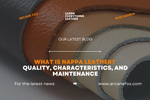
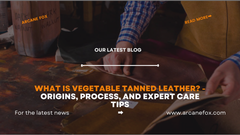
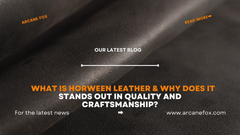
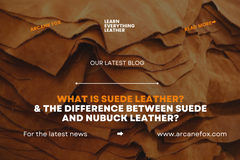
1 comment
This blog beautifully explains faux leather’s quality and durability, making it a must-read for anyone exploring sustainable materials. Great job!